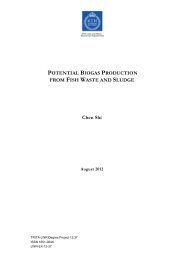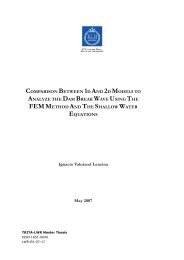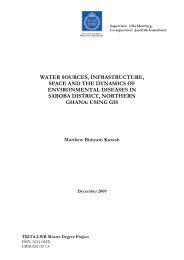radon in groundwater - Mark- och vattenteknik - KTH
radon in groundwater - Mark- och vattenteknik - KTH
radon in groundwater - Mark- och vattenteknik - KTH
- No tags were found...
You also want an ePaper? Increase the reach of your titles
YUMPU automatically turns print PDFs into web optimized ePapers that Google loves.
Kirlna Skeppström TRITA LWR.LIC 2032water conta<strong>in</strong><strong>in</strong>g 1000 Bq/l. Groundwater isextracted from different sources and<strong>groundwater</strong> from bedrock aquifers (drilledwells) has a greater potential of conta<strong>in</strong><strong>in</strong>gan enhanced concentration of 222 Rn than<strong>groundwater</strong> extracted from soil aquifers <strong>in</strong>dug wells (Åkerblom and L<strong>in</strong>dgren, 1997).In bedrock aquifers, <strong>groundwater</strong> occurs andflows <strong>in</strong> fractures. Radium-rich m<strong>in</strong>eralspresent along the surfaces of fractures decayand release 222 Rn atoms <strong>in</strong>to <strong>groundwater</strong>.S<strong>in</strong>ce the recoil distance as well as the diffusionlength of 222 Rn is small (Tanner, 1980),it is widely accepted that only those m<strong>in</strong>eralsly<strong>in</strong>g on the surfaces of fractures, <strong>in</strong> directcontact with the <strong>groundwater</strong>, contribute to<strong>in</strong>creased 222 Rn levels <strong>in</strong> the water. Changes<strong>in</strong> <strong>groundwater</strong> chemistry can lead to differentm<strong>in</strong>eral fluid <strong>in</strong>teractions (Siegel andBryan, 2004). 238 U is affected by redox conditions.When an oxidis<strong>in</strong>g environmentprevails, 238 U enters solution and is transportedalong with the water and is eventuallyprecipitated <strong>in</strong> a reduc<strong>in</strong>g environment(Schumann and Gundersen, 1996). 226 Raoccurrence and distribution <strong>in</strong> <strong>groundwater</strong>is guided by its production from its immediateparent isotope thorium ( 230 Th) and itsremoval from solution is governed by theadsorption or cation exchange properties(Herczeg et al., 1988). The re-deposition of238 U and 226 Ra along the walls of a fracture isknown as secondary m<strong>in</strong>eral enrichment andcontributes to significantly <strong>in</strong>creas<strong>in</strong>g theconcentration of222 Rn <strong>in</strong> <strong>groundwater</strong>(Åkerblom and L<strong>in</strong>dgren, 1997).The above-mentioned microscopic processescomb<strong>in</strong>ed with the heterogeneity offractures <strong>in</strong> a rock matrix often make itdifficult to quantify transport of radioactiveelements <strong>in</strong> a bedrock aquifer. Not all fracturesare hydraulically significant - only a feware hydraulic conductors and facilitate fluidflow (NRC, 1996; Olofsson et al., 2001).However, despite the complexity of thebedrock aquifer system, there is still a needto predict <strong>radon</strong> potential <strong>in</strong> <strong>groundwater</strong>. InSweden and other countries, a large numberof people depend on <strong>groundwater</strong> extractedfrom bedrock aquifers for their daily waterneeds, imply<strong>in</strong>g long-term exposure to radioactive222 Rn <strong>in</strong> some cases. At municipallevel, prediction of <strong>radon</strong> potential <strong>in</strong><strong>groundwater</strong> is important for the plann<strong>in</strong>gof new hous<strong>in</strong>g areas, as well as the considerationof remediation measures for exist<strong>in</strong>ghouses. In order to make realistic predictionof 222 Rn levels <strong>in</strong> <strong>groundwater</strong>, <strong>in</strong>fluenc<strong>in</strong>gfactors should be studied <strong>in</strong> a holistic way.Many studies conducted on <strong>radon</strong> <strong>in</strong> thenatural environment are pr<strong>in</strong>cipally surveysand <strong>in</strong>volve sampl<strong>in</strong>g and measurements of<strong>radon</strong> <strong>in</strong> <strong>groundwater</strong>. Such studies areperformed for different reasons, <strong>in</strong>clud<strong>in</strong>gsearch<strong>in</strong>g for uranium deposits, search<strong>in</strong>gfor thrust and faults, search<strong>in</strong>g for seismicrelatedchanges and also for better knowledgeof the spatial distribution of <strong>radon</strong>(Monn<strong>in</strong> and Seidel, 1992; Choubey et al.2001; Porsani et al., 2005; Schubert et al.,2005; Ishikawa et al., 2005). Such surveys arenecessary steps <strong>in</strong> the reconnaissance of anarea prior to more detailed analyses regard<strong>in</strong>g<strong>in</strong>fluenc<strong>in</strong>g factors. Other studies focusma<strong>in</strong>ly on geological aspects, such as bedrockcomposition and uranium occurrenceand distribution <strong>in</strong> bedrock. Åkerblom andL<strong>in</strong>dgren (1997) <strong>in</strong>vestigated bedrock andsoil data <strong>in</strong> Sweden with the aim of mapp<strong>in</strong>gthe <strong>groundwater</strong> <strong>radon</strong> potential. Choubeyet al. (2000) <strong>in</strong>vestigated hydrogeology andfound that the <strong>groundwater</strong> flow characteristics<strong>in</strong>fluence the concentration of <strong>radon</strong> <strong>in</strong>spr<strong>in</strong>gs. Other studies related to bedrockand distribution of uranium <strong>in</strong>clude thework of Lidén et al. (1995), Ståhl (1997),Choubey and Ramola (1997) and Salih et al.(2002). Studies on temporal variations <strong>in</strong><strong>radon</strong> <strong>in</strong> <strong>groundwater</strong> are few. Knutsson(1977) studied seasonal fluctuations for dugwells and found large variations depend<strong>in</strong>gon type of soil aquifer. Nilssen (2001) observedlarge fluctuations <strong>in</strong> 222 Rn concentration<strong>in</strong> drilled wells from granite rocks.Regard<strong>in</strong>g <strong>radon</strong> and <strong>groundwater</strong> chemistry,only a few correlation studies have beenperformed (Lew<strong>in</strong> Pihblad, 1998; Lew<strong>in</strong> andSimeonidis, 1998; Salih et al., 2004). Most ofthe research work related to <strong>groundwater</strong>chemistry focuses pr<strong>in</strong>cipally on the parentelements of 238 U and 226 Ra (Waite et al.,1994; Schumann and Gundersen, 1996;2
















